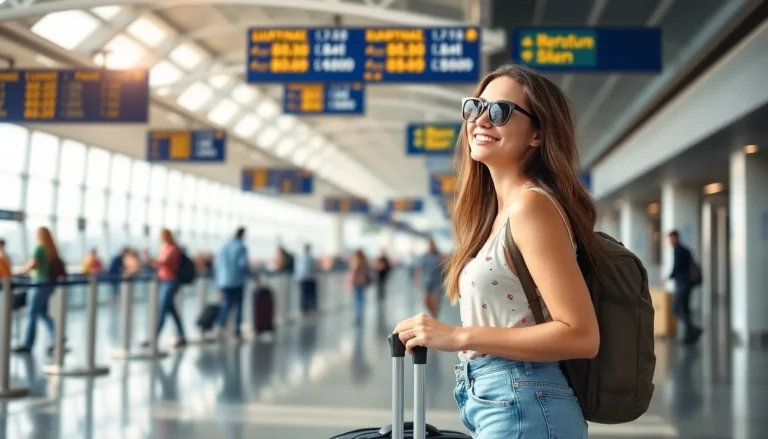Managing a business travel budget can feel like trying to solve a Rubik’s cube blindfolded – tricky yet essential for company success. As organizations expand globally modern businesses must balance the need for face-to-face interactions with financial responsibility.
Smart companies know that effective travel spending isn’t about pinching pennies – it’s about maximizing return on investment. From airfare and accommodations to meals and ground transportation business travel expenses typically represent 10-12% of an organization’s total budget. That’s why establishing a clear well-managed travel budget has become crucial for businesses of all sizes.
Understanding Business Travel Budget Essentials
Business travel budgets encompass multiple interconnected financial elements that require careful monitoring. These elements form the foundation for effective cost management across all travel-related activities.
Key Components of Travel Expenses
Travel expenses break down into five primary categories that impact the overall budget:
- Transportation costs include airfare, train tickets, car rentals or mileage reimbursement
- Accommodation expenses cover hotel stays, service charges, taxes
- Meal allowances define daily food expense limits for breakfast, lunch, dinner
- Ground transportation encompasses taxis, rideshares, airport transfers
- Incidental costs contain baggage fees, internet access, phone charges, tips
| Expense Category | Average Percentage of Total Budget |
|---|---|
| Transportation | 40-45% |
| Accommodation | 25-30% |
| Meals | 15-20% |
| Ground Transport | 5-10% |
| Incidentals | 5-8% |
Setting Realistic Budget Parameters
Effective budget parameters rely on three core elements:
- Historical spending data provides baseline costs for similar trips
- Destination-specific research reveals local price variations in major cities
- Season-based adjustments account for peak vs off-peak travel rates
| Parameter Type | Impact on Budget |
|---|---|
| Peak Season | +25-35% |
| Major Cities | +40-50% |
| Rural Areas | -20-30% |
- Monthly spend tracking across departments
- Quarterly budget reviews comparing actual vs planned expenses
- Annual assessments of cost-saving opportunities
- Vendor contract evaluations for preferred pricing
Cost-Saving Strategies for Corporate Travel

Strategic cost management in corporate travel combines policy implementation with strategic partnerships to optimize travel spending. Organizations reduce expenses by 20-30% through structured approaches to travel management.
Implementing a Travel Policy
A comprehensive travel policy establishes clear guidelines for business travel expenditures. Organizations report 23% lower travel costs after implementing standardized booking procedures through designated corporate travel platforms. The policy includes specific spending limits for hotels ($150-250 per night), meals ($75-100 per day) and transportation options. Advanced booking requirements (14+ days for flights) generate 15-20% savings on airfare costs. Clear approval processes streamline expense management while automated systems flag out-of-policy bookings. Mobile apps enable travelers to track expenses in real-time ensuring policy compliance.
Leveraging Corporate Partnerships
Corporate partnerships create substantial cost savings through negotiated rates and volume discounts. Companies save 25-35% on hotel stays through preferred vendor agreements with major hotel chains. Airline partnerships provide 10-15% discounts on published fares plus added benefits like flexible booking options. Corporate card programs offer 1-3% cashback on travel purchases while providing detailed spending analytics. Travel management companies reduce booking fees by 30-40% through consolidated purchasing power. Partner loyalty programs accumulate points for future business trips reducing overall travel costs.
Technology Tools for Budget Management
Modern travel expense management relies on digital tools to streamline processes, enhance accuracy, and provide real-time visibility into spending patterns.
Expense Tracking Software
Automated expense tracking systems integrate with corporate credit cards to capture real-time spending data. Leading platforms like SAP Concur and Expensify offer mobile apps that sync transactions directly into expense reports. These systems categorize expenses automatically, applying preset rules for travel policy compliance. Organizations using expense tracking software report 87% faster reimbursement processing and reduce errors by 95%. Enterprise-grade solutions provide:
- Built-in policy controls to flag non-compliant expenses
- Integration with accounting software for seamless reconciliation
- Custom reporting dashboards for spend analysis
- Multi-currency support for international travel
- Automated approval workflows for faster processing
Digital Receipt Management
Digital receipt management eliminates paper-based processes through optical character recognition (OCR) technology. Mobile apps enable travelers to capture receipts instantly, extracting key data points such as date, amount and merchant information. Cloud-based storage systems organize receipts by:
- Trip identifiers for easy access
- Expense categories for accurate reporting
- Employee profiles for quick reference
- Project codes for cost allocation
- Tax compliance requirements
The implementation of digital receipt management reduces processing costs by 75% and cuts receipt handling time from 20 minutes to 3 minutes per report. Storage solutions maintain audit-ready records for 7 years while enabling instant retrieval through searchable databases.
Common Budget Allocation Mistakes
Business travel budgets frequently suffer from misallocation due to overlooked factors and poor planning processes. These mistakes impact overall financial performance and create unnecessary cost overruns.
Over-Spending Red Flags
Common overspending indicators appear in multiple expense categories of business travel. Late bookings cost organizations 35% more on average for airfare purchases. Excessive meal expenses occur when per diem limits remain undefined, leading to 25% higher food costs. Unauthorized upgrades on flights and hotels add 40% to standard travel costs. Non-compliant bookings through unauthorized channels bypass negotiated corporate rates, resulting in 20% higher expenses. Out-of-policy expense submissions increase processing time by 3x and create additional administrative costs.
Budget Forecasting Errors
Inaccurate forecasting stems from incomplete data analysis and market trend oversight. Organizations underestimate inflation impacts on travel costs by 15% on average. Seasonal price fluctuations affect hotel rates by 30-45% during peak periods. Currency exchange rate variations impact international travel expenses by 10-20%. Fixed budget allocations ignore department-specific travel patterns, creating 25% variance in actual versus projected spending. Historical data limitations lead to 40% of companies setting unrealistic travel budgets. Market rate changes in transportation costs affect overall travel expenses by 20-35% annually.
Maximizing ROI on Business Travel
Business travel ROI quantifies the financial returns generated from travel expenditures relative to costs invested. Strategic measurement of travel ROI enables organizations to optimize spending patterns for maximum business impact.
Measuring Travel Expenses Against Revenue
Travel expense ratios establish clear correlations between travel spending and revenue generation. Organizations track expense-to-revenue ratios quarterly to identify high-performing travel activities. A benchmark ratio of 1:3 indicates $3 in revenue for every $1 spent on travel. Companies categorize travel expenses by purpose (sales meetings, conferences, training) to analyze revenue impact per category. The data reveals which travel activities generate optimal returns, enabling targeted budget allocation adjustments.
Performance Metrics to Track
Key performance indicators provide actionable insights into travel ROI effectiveness:
| Metric | Target Range |
|---|---|
| Cost per Trip | $800-1,200 |
| Revenue per Trip | $2,400-3,600 |
| Booking Lead Time | 14-21 days |
| Policy Compliance | 90-95% |
| Expense Processing Time | 24-48 hours |
Travel managers monitor average deal size from in-person meetings versus virtual interactions. Client retention rates increase 25-35% through regular face-to-face meetings. Customer acquisition costs decrease 15-20% when leveraging strategic travel planning. Response times between booking requests and approvals impact overall program efficiency.
Conclusion
Managing a business travel budget requires a strategic balance of cost control and value generation. By implementing comprehensive policies leveraging technology solutions and establishing strong vendor partnerships organizations can achieve significant cost savings while maximizing their return on investment.
Success in travel budget management relies on data-driven decisions careful monitoring and regular assessment of spending patterns. Companies that adopt these practices along with modern digital tools can expect to reduce their travel expenses by 20-30% while maintaining the effectiveness of their business travel programs.
The future of business travel budgeting lies in smart allocation flexible policies and measurable outcomes. Organizations that embrace these principles will be well-positioned to thrive in an increasingly global business environment where strategic travel remains essential for growth and success.




